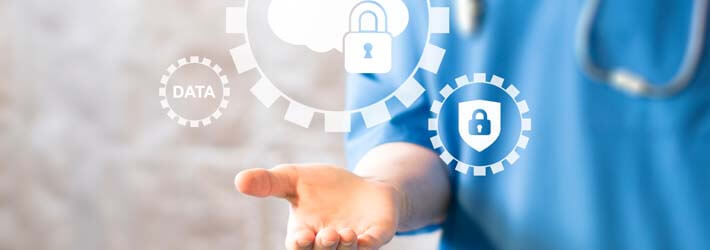
It’s not surprising that data security has become a top priority for IT professionals in the healthcare industry. During 2021, nearly 45 million healthcare records were either exposed or stolen in 686 significant breaches, according to GLOBE NEWSWIRE. These stolen records account for 95% of all identity theft incidents and hold a value 25 times that of a credit card. The goal of data security in healthcare operations is to create a robust and streamlined strategy that guarantees maximum protection for patient information. To help with this, the Health Insurance Portability and Accountability Act (HIPAA) offers guidance on the appropriate management of sensitive healthcare data.
Most Common Healthcare Data Threats
The main threats to healthcare data are phishing, ransomware attacks, data breaches, and DDoS attacks. Phishing is when hackers deceive someone into revealing sensitive information by pretending to be someone trustworthy. Ransomware attacks use malware to gain control of a computer or network, demanding a ransom for access to be restored. Data breaches involve hackers stealing or manipulating healthcare data, sometimes as a precursor to a ransomware attack. DDoS attacks overwhelm a web server with fake requests, disrupting its normal function and preventing legitimate users from accessing the site.
Steps for Healthcare Data Protection
This section provides an overview of the essential steps that healthcare providers should follow to safeguard healthcare data, including risk assessments, robust authentication measures, encryption, secure data storage, staff training, and disaster recovery plans. By implementing these measures, healthcare providers can not only mitigate the risks but also uphold patient trust and maintain the integrity of the healthcare system.
Use of Data Encryption: Sensitive data is protected during transmission by using encryption, which requires a secret decryption key to read the encrypted data.
Use of Anti-Virus Apps: Detect and prevent viruses from entering the healthcare organization’s network, as well as scan systems for existing malware.
System Monitoring Apps: The monitoring of network endpoints and inspection of the entire system enables IT teams to identify potential breaches or unauthorized access and leads to the detection of suspicious activity.
Enabling Multi-factor Authentication (MFA): MFA requires additional information beyond just a username and password, which can include security questions, physical devices with authentication credentials, or biometric data.
Ransomware Protection: Some cybersecurity companies offer decryption keys to protect against malware specifically designed to spread ransomware and regain control of compromised systems.
Employee Training: Educate employees on protecting access credentials and devices, raise awareness about cyber threats and the assets they target, and teach best practices for data security.
Best Practices for Proactive Healthcare Security
Below are the ten most notable best practices for proactive healthcare security:
1. Conduct regular risk assessments: Identify and assess potential security risks within the healthcare organization. This includes assessing the physical infrastructure, network systems, and employee practices.
2. Implement strong access controls: Ensure that only authorized individuals have access to patient information and sensitive systems. This includes using strong passwords, multi-factor authentication, and regularly reviewing and updating access privileges.
3. Encrypt patient data: Use strong encryption methods to protect patient data both in transit and at rest. Encryption ensures that even if data is compromised, it remains unreadable to unauthorized parties.
4. Train employees on security best practices: Provide regular training sessions to employees on security protocols, including password hygiene, recognizing phishing attempts, and being vigilant against potential security threats.
5. Regularly update and patch systems: Keep all software, operating systems, and connected devices updated with the latest security patches. Regularly evaluating and updating security protocols is crucial to protect against vulnerabilities and security gaps.
6. Monitor network activity: Implement network monitoring tools and systems to detect and respond to any suspicious or unauthorized activity. This includes logging and analyzing system logs, firewall logs, and intrusion detection system alerts.
7. Conduct regular security audits: Regularly review and assess security practices and protocols to ensure they are effective and up to date. This involves conducting internal and external security audits, penetration testing, and vulnerability assessments.
8. Implement incident response and disaster recovery plans: Have a well-documented incident response plan in place to effectively handle security breaches or incidents. Also, create a disaster recovery plan to ensure that patient data can be recovered and operations can resume in the event of an incident.
9. Foster a culture of security: Promote a culture of security awareness among employees, emphasizing the importance of data protection and patient privacy. Encourage reporting of potential security incidents and ensure employees feel comfortable discussing security concerns.
10. Stay informed about emerging threats: Stay up to date with current and emerging cybersecurity threats in the healthcare industry. Engage in ongoing education and collaborate with industry partners to share information and best practices for proactive security.
Pros and Cons of Digitization in Healthcare
Digitization in healthcare has both advantages and disadvantages. On the positive side, it allows healthcare organizations to centralize data management, improve communication with various stakeholders, and analyze data for better care and efficiency. However, digitization also increases the risk of data breaches, as hackers can exploit the vast amount of digitized information for fraudulent activities. Additionally, consolidating multiple digital systems under a single solution makes it easier for attackers to gain access to sensitive data. Cloud-based systems are particularly vulnerable if an attacker steals cloud access credentials.
Future Trends of Healthcare Data Security
Regulatory changes may be the major catalyst for a significant transformation in healthcare data center security in the future. While HIPAA provides useful guidelines, it falls short in providing explicit instructions on leveraging technology to safeguard different types of healthcare data. Consequently, it is highly probable that the industry will witness the implementation of more precise regulations aimed at enhancing data protection measures within healthcare organizations.
How Lepide Helps Improve Healthcare Data Security
The Lepide Data Security Platform helps organizations monitor permissions to access health information, track changes made to health information, audit computers storing health information, and monitor group memberships. This allows organizations to prevent unauthorized access and ensure the appropriate levels of privilege are assigned to employees.
The Lepide platform uses machine learning models to analyze vast amounts of healthcare data and identify abnormal user behavior, detecting patterns that deviate from normal behavior. For instance, if a user typically logs in from a consistent device and time but suddenly starts logging in from a different device and time, this activity would be flagged as unusual. To promptly address potential threats, real-time alerts can be sent to your inbox or mobile app. Furthermore, the Lepide software can recognize and respond to events that meet a predefined threshold condition. For example, if numerous files are encrypted or renamed within a brief timeframe, a customized script can be automatically executed which may disable an account or process, modify relevant settings, or initiate the shutdown of the affected server.
How Lepide Helps to Meet HIPAA Compliance Requirements
Auditing Permissions for Health Data Access: In some cases, changes in permissions can lead to unauthorized access to sensitive health data, potentially resulting in data leakage. Lepide consistently audits permission changes for various platforms such as Active Directory, Exchange Server, SharePoint, SQL Server, Windows File Server, NetApp Filer, Office 365, and Dropbox. It allows you to compare permissions of Active Directory objects over different periods.
Monitoring Health Information Changes: HIPAA regulations require monitoring of users with access to electronic health information. Lepide effectively monitors user activities and configuration changes related to critical health information. These changes are presented in predefined reports that provide valuable insights. Real-time alerts can be set up for critical changes, notifying recipients via email or through the Lepide Mobile App.
Auditing Computers that Store Health Information: Lepide conducts audits on modifications made to computer objects in Active Directory. It keeps track of users with access permissions to these computers and captures logon/logoff events for future reference. Additionally, Lepide audits changes to network access policies, ensuring control over computer connections to external networks. Modifications in user logon hours are also audited.
Monitoring Group Memberships: Permissions are commonly assigned to users through groups. Any sudden changes in group memberships can pose potential risks, granting unnecessary or inappropriate privileges to employees who don’t require them. Lepide allows you to monitor groups and receive real-time notifications for any changes in memberships or properties.
If you’d like to see how the Lepide Data Security Platform can help to keep your protected health information secure, schedule a demo with one of our engineers.

